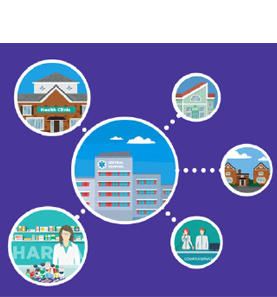Findings
Creation of collaborative internal & cross-centre networks

Creation of collaborative internal & cross-centre networks


Patients
HCPs
Healthcare systems
Le Roux E, et al. GPs experiences of diagnosing and managing childhood eczema, BJGP 2019 [PDF] https://bjgp.org/content/bjgp/early/ 2018/01/16/bjgp18X694529.full.pdf Assessed 21 Mar 2019;
Allergy UK and Sanofi Genzyme. Seeing Red: Getting under the skin of adult severe eczema. 2017 [Website] https://www.allergyuk.orghttps://live-secureportal.azurewebsites.net/000/ 001/411/Seeing_Red_Report_FINAL_25.04.17_original.pdf? 1508228476 Accessed 5 Nov 2019; (c) KPMG interviews
Note: With input from the steering committee, we have categorised these activities by level of resource required to implement, however this may vary across centres/settings (e.g. depending on existing resources)
Collaboration on local, national or international research projects
Clinical trials participation, DermAssociates (Washington), USA
Integrated clinical and research laboratories, Aarhus Universitetshospital, Denmark
PCP-Dermatology-Laboratory network, UNIMORE (Modena), Italy
Specialist laboratory attesting and interpretation, UNIMORE (Modena), Italy
Working with the VMCE, UMC Utrecht, Netherlands/UMC Groningen, Netherlands
Pruritus National Reference Centre, CHRU Brest, France
National patient database, Linkou Chang Gung Memorial Hospital (Taipei), Taiwan
Development of Japanese guidelines for AD, Hiroshima University Hospital, Japan
Collaboration on the provision of patient and HCP education
Globally trained dermatologists and residents, Rabin Medical Centre (Petah Tikva), Israel
Healthcare professional education, UniCATT (Rome), Italy
Healthcare professional education seminars, Hiroshima University Hospital, Japan
Primary care dermatology education, Hospital La Paz (Madrid), Spain
Provision of HCP education, UKSH (Kiel), Germany
Building relationships with local centres of comorbidity specialists for referrals
Comorbidity specialist network, DermAssociates (Washington), USA
Established specialist network, Medical Dermatology Associates of Chicago, USA
Referral to co-morbidity specialists, M.L.F. Knuckles Dermatology (Kentucky), USA
Enabling teleconsultations between specialists and other specialists or Primary Care Practitioners
Emergency room specialist hospital communication app, Rady Children's Hospital (California), USA
Teledermatology service, Royal Devon & Exeter Hospital, UK
Use of telemedicine, Hospital Italiano de Buenos Aires, Argentina
Cross-centre development of treatment principles/care algorithms, guidelines and recommendations, AD scoring indices, PRO or QoLmeasures etc.
Consensus for the management and treatment of AD, Linkou Chang Gung Memorial Hospital (Taipei), Taiwan
Development of Japanese guidelines for AD, Hiroshima University Hospital, Japan
Harmonising Outcome Measures for Eczema (HOME) Initiative, Rabin Medical Centre (Petah Tikva), Israel / OHSU (Oregon), USA
A community-based assessment of skin care, allergies and eczema (CASCADE) trial, OHSU (Oregon), USA
Developing AD educational and health information technology resources (e.g. ‘smartset’) for paediatricians (and their patients) in primary care
Healthcare professional education, UniCATT (Rome), Italy
Improving Atopic Dermatitis Care by Paediatricians (IADCBP), Rady Children's Hospital (California), USA
Integrating a community dermatologist into specialist centre outpatient clinics
Integrated community dermatologist, Rabin Medical Centre (Petah Tikva), Israel
Integration of community dermatologists, Women’s College Hospital (Toronto), Canada
National cross-centre setup and participation in AD registries and biobanks
BioDay registry, UMC Utrecht, Netherlands/UMC Groningen, Netherlands
TREATgermany registry, UKSH (Kiel), Germany/CMSS (Selters), Germany
Providing specialist care in the community via smaller clinics/satellite clinics
Community outreach clinics for rural populations, Harrogate District Hospital, UK
Hospital Specialist Satellite Clinics, Rady Children's Hospital (California), USA
Supporting setup and/or running of Patient Groups
Working with the VMCE, UMC Utrecht, Netherlands/UMC Groningen, Netherlands
Working with the AADA, Hospital Sant Pau (Barcelona), Spain/Hospital La Paz (Madrid), Spain
Involvement with wider AD community, Mount Sinai & Ichan School of Medicine (New York), USA
Creating a cross-centre regional network of HCPs involved in the management of eczema who meet regularly
Centre Expert Eczema Network Auvergne Rhone Alpes, CH Lyon-Sud, France
Providing a HCP smartphone application portal for centre network
MedPhone application, CH Lyon-Sud, France
Hiring HCPs who have trained at other national or international centres
Globally trained dermatologists and residents, Rabin Medical Centre (Petah Tikva), Israel